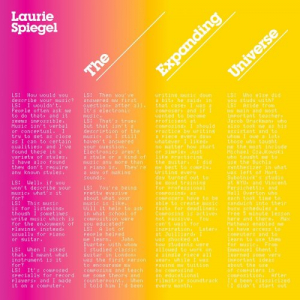Laurie Spiegel - The Expanding Universe '2012

| Artist | Laurie Spiegel Related artists |
| Album name | The Expanding Universe |
| Country | |
| Date | 2012 |
| Genre | Electronic |
| Play time | 78:09 + 78:22 |
| Format / Bitrate | Stereo 1420 Kbps
/ 44.1 kHz MP3 320 Kbps |
| Media | CD |
| Size | 795 MB |
| Price | Download $6.95 |
Order this album and it will be available for purchase and further download within 12 hours
Pre-order album Tracks list
Tracks list
Tracklist: CD 1: 01. Patchwork (9:46) 02. Old Wave (6:53) 03. Pentachrome (7:18) 04. A Folk Study (2:03) 05. Drums (7:09) 06. Appalachian Grove I (5:22) 07. Appalachian Grove II (7:56) 08. Appalachian Grove III (3:14) 09. The Expanding Universe (28:28) CD 2: 01. East River Dawn (14:16) 02. The Unquestioned Answer (6:30) 03. The Orient Express (10:02) 04. Clockworks (5:22) 05. Dirge Part I (2:20) 06. Dirge Part II (2:31) 07. Music For Dance Part I (8:37) 08. Music For Dance Part II (6:20) 09. Keplers Harmony Of The Worlds (10:40) 10. Wandering In Our Times (11:44) Earlier than most, Laurie Spiegel recognized that computers could offer the complete freedom to define any kind of world you wanted and work within it. Her compositions from the 70s and 80s were coded instead of written, revealing new horizons for improvisation and experimentation while remaining accessible. In those decades, Philip Glass and Steve Reich were her contemporaries in the close-knit experimental scene of downtown New York. But Spiegel continues to set herself apart from the high-profile minimalist movement, preferring the term slow change music. Her innovations to American and electronic music have by now gone down in history, but her rise to recognition has been as slow and subtle as her compositions. Because it transcended known genres, her first album, The Expanding Universe, was picked up by the folk label Philo Records. (Spiegel recently said it had the impact of a mere drop of rain falling into the ocean.) It wasnt until 2012, when the label Unseen Worlds reissued The Expanding Universe, that many were able to hear these pieces for the first time. (The label has now pressed the album again, and has also given Spiegels second album, Unseen Worlds, a first vinyl pressing.) Recorded nearly a decade apart, these works reflect the changing role of the computer from a cumbersome machine kept behind institutional doors to its place in the home as a personal tool. The personality of the compositions shapeshifted as well, from primarily buoyant and melodic tendencies in The Expanding Universe to unsettling soundscape-driven scores in Unseen Worlds. The Expanding Universes cover art suggests a vivid sunset, setting the mood for what lies within. Sporting lush tones flying up and down scales, the opening track, Patchwork, embraces the listener with optimistic energy. The timbre is surprisingly warm for a completely digital album. The ability to shift the timbre was fairly limited on the technology available, but the textures still ended up being intimate, humanizing the synthetic nature of digital tools. It suggested that a personal relationship to both computers and the cosmos were within our reach. The Expanding Universe is a 30-minute meditation of modulated droning that captures the albums ethos: to make music that Spiegel could feel close to… which should have existed somewhere, but which [she] hadnt been able to find. In contrast, Keplers Harmony Of The Worlds was programmed with astronomical calculations, made by Johannes Kepler in 1619, to anxiously screeching ends, like a chorus of earthquake emergency alarms sounding at once. Carl Sagan caught wind of Spiegels sonic experiments and, recognizing their mathematical beauty, asked that it be etched into two gold-plated records and sent into space with the 1977 Voyager mission. Meant to be found by intelligent extraterrestrials, these records are still hurtling through space, many billions of kilometers away from Earth. Such experiments were only possible with the unique access to a new computing protocol named GROOVE. Spiegel saw an opportunity to streamline the composition process while retaining the potential to improvise. But once the GROOVE system became obsolete, Spiegel decided to make her own music software. She wrote one of the first widely-accessible music composition programs, Music Mouse, which could be downloaded on then-popular platforms such as Mac and Atari. If you grew up learning to use a mouse before you learned to read, you might take this innovation for granted. Accessible software cut away many gatekeepers of the music world and set the stage for the development of programs such as Ableton. Music Mouse was one of the programs Spiegel used on Unseen Worlds. If The Expanding Universe is a gleaming astral body, then its follow-up, Unseen Worlds, is the dark matter of Spiegels universe. It seems like a response to the limited timbre of its predecessor, offering a spindly architecture of atmosphere and texture that leaves one in nail-biting suspense. The Doppler effects on Three Sonic Spaces suggest three-dimensional space and a sense of falling. Sound Zones and Riding The Storm are straight-up frightening, as if the impending disaster hinted at in earlier tracks is reaching fever-pitch. The title of Strand Of Life (Viroid) points to its short and simple form: viroids are the smallest discovered infectious pathogens, the menacing elegance of a single, circular strand of RNA. Despite titular and sonic references to heavenly bodies and microorganisms, these albums also embrace the sublime moments found in everyday experience. Picture the feeling of having stayed up all night on the Lower East Side… then looking out through the hazy dawn air at the river, read Spiegels liner notes to East River Dawn, and its easy to feel the melodic tones accumulate and drip like morning dew on a window pane. The last line reads: The day feels full of potential.
